Understanding Brown Tint in Eyes: A Comprehensive Exploration
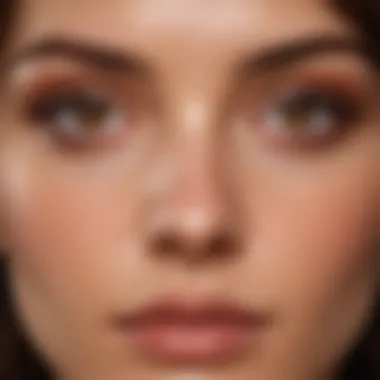
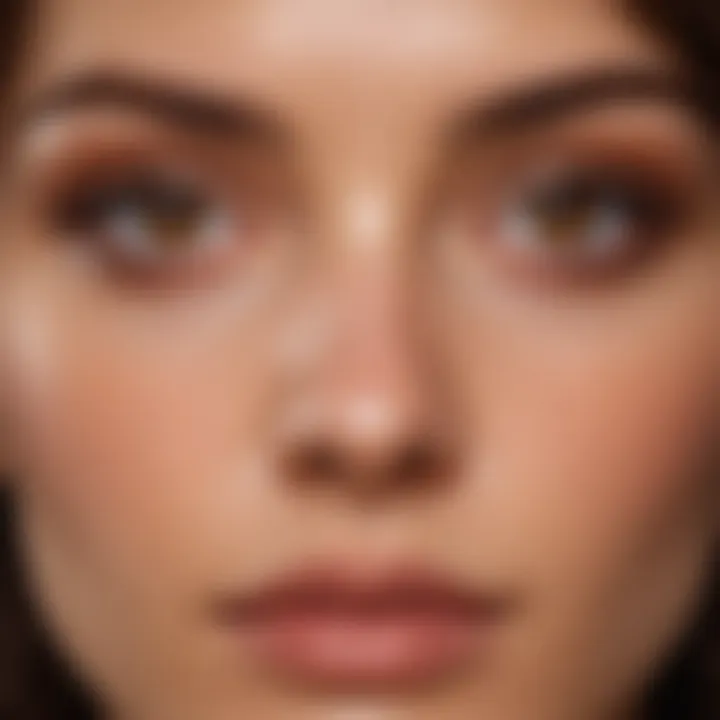
Intro
The presence of a brown tint in the eyes is both a biological marvel and an aesthetic consideration. Eye color is primarily determined by genetic factors. The interplay of melanin in the iris influences whether an individual has lighter or darker eye shades. Brown eyes contain more melanin compared to other shades. This article aims to dissect the complexities of brown-tinted eyes, examining how this trait affects beauty standards and cultural perceptions around the globe.
Understanding the implications of brown eyes involves various dimensions, such as genetic inheritance and social significance. This narrative will delve into these aspects in a way that appeals especially to women of diverse ages seeking informed insights into their beauty and appearance.
Tips and How-Tos
Enhancing the beauty of brown eyes can involve strategic choices in skincare and makeup. While makeup application is vital, a solid foundation rests on appropriate skincare routines. For women with varying skin types, it is essential to address skin concerns before applying makeup.
Skincare Routines for Different Skin Types
- Oily Skin:
- Dry Skin:
- Combination Skin:
- Use a foaming cleanser to remove excess oil.
- Lightweight, oil-free moisturizer is recommended.
- Consider adding a mattifying primer before makeup application.
- Opt for cream-based cleansers that hydrate.
- Rich moisturizers will help keep the skin supple.
- Hydrating primer can enhance makeup longevity.
- Use a balancing cleanser to cater to both oily and dry areas.
- Lightweight moisturizers should be applied to oily areas.
- A gel-based primer could provide balance.
Haircare and Styling Basics
Hair color and styling can complement the rich tones of brown eyes. Here are essential tips for styling:
- Highlighting: Subtle highlights can brighten the face and enhance eye color.
- Cutting: Certain hairstyles can frame the eyes well, drawing attention to them.
- Coloring: Warm tones in hair can enrich the effect of brown eyes, making them appear even more vibrant.
Sustainable Practices
As awareness of environmental issues increases, many individuals seek sustainable beauty options. Choosing eco-conscious products is one way to make a positive impact.
Eco-Friendly Fashion Brands
Many brands now focus on sustainable practices, promoting not only fashion but also environmental responsibility. Some notable options include:
- Patagonia: Known for their commitment to sustainability in outdoor wear.
- Reformation: Offers trendy styles while prioritizing eco-friendly materials.
- Everlane: Focuses on transparency in their production methods.
Tips for Sustainable Grooming
- Use multi-purpose products to reduce waste.
- Choose natural makeup brands that avoid harmful chemicals.
- Recycle beauty containers whenever possible to minimize landfill impact.
Celebrating Diversity in Beauty
The representation of brown eyes has cultural relevance. Various cultures worldwide embrace brown eyes, often celebrating their connection to heritage and identity. It's important for brands to reflect this diversity.
Inclusive Beauty Brands
Some beauty brands prioritize inclusivity, catering to a wide array of skin tones and features:
- Fenty Beauty creates products for all shades, making beauty accessible.
- NYX Cosmetics offers an extensive color selection suitable for diverse needs.
Cultural Influences on Fashion
Fashion is often influenced by cultural trends that celebrate diversity in beauty. Women with brown eyes may find themselves at the center of these dynamic shifts, as different cultures value various features and styles. Understanding these influences can help one appreciate their unique beauty more profoundly.
"Beauty is wherever you find it, and often in unexpected places."
The exploration of brown-tinted eyes stretches beyond mere genetics. It encompasses broader implications encompassing beauty, body positivity, and cultural appreciation.
The Science Behind Eye Color
The study of eye color is crucial for understanding the biological processes that dictate not just aesthetics but also genetic identity. Brown eyes, which are the most common globally, serve as a fascinating subject of study. The article seeks to explore how genetic factors influence the creation of brown tints in the eyes, providing a clearer comprehension of their characteristics and significance. Through this exploration, readers can appreciate the scientific elements that contribute to the diversity of eye colors and the allure of brown eyes in particular.
Genetic Influences on Eye Color
Genetics play an essential role in determining eye color. This feature is controlled by multiple genes, with the two most significant ones being OCA2 and HERC2. These genes are responsible for the production and regulation of melanin in the body, a critical pigment that influences the shade of one's eyes. Studies show that variations in these genes can lead to differences in melanin concentration, ultimately resulting in various eye colors, from light blue to deep brown.
Brown eyes occur due to high concentrations of melanin. The more melanin present, the darker the eyes will appear. It is interesting to note that having brown eyes is associated with a dominant allele in genetics. In contexts of inheritance, if one parent has brown eyes, there is a significant chance that their children will inherit this trait. Thus, understanding genetic influences helps clarify why brown eyes are widespread and how they can be seen across diverse populations.
Melanin and Its Role
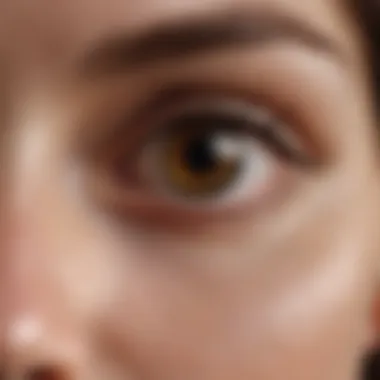

Melanin is a vital factor in eye color determination. This pigment exists in various forms, primarily eumelanin and pheomelanin. Eumelanin provides darker tones, including brown and black, while pheomelanin contributes lighter hues such as those seen in green or golden eyes. In brown-eyed individuals, the concentration of eumelanin is particularly high, which absorbs more light, resulting in the brown tint.
The production of melanin is stimulated by exposure to sunlight, which can also lead to subtle shifts in the eye's color over time. In response to varying environmental factors, the levels of melanin can fluctuate, demonstrating how melanin is not only determined by genetics but can also be affected by environmental conditions.
Eye Color Variations
Eye color is not just black and white; it encompasses a spectrum of shades that can be a source of pride and intrigue. Brown eyes, in particular, can exhibit multiple variations, including hazel, amber, and chocolate tones.
Hazel eyes combine brown with green, creating a unique appearance influenced by lighting and surroundings. Amber, a less common shade, presents a golden or coppery hue. Such variations are the result of the different distributions and concentrations of melanin as well as structural factors in the eyes.
Furthermore, the perception of brown eye shades can change. For example, lighting conditions can significantly influence how brown appears, making it look richer or paler. Understanding these variations enhances appreciation for the depth and richness of brown eye color and its attractiveness across different contexts.
"Eye color, with its varying shades and influences, offers a glimpse into the complex interplay of genetics and environment."
The significance of studying these elements combines biological curiosity with practical applications, such as in fashion and beauty, where knowing what complements specific shades can enhance personal expression. In this light, the science behind eye color transcends mere aesthetics; it encapsulates identity and individuality.
The Aesthetic Appeal of Brown Eyes
Brown eyes possess a unique charm that has made them the subject of admiration across cultures. Aesthetic appeal goes beyond mere colors; it reflects an intricate blend of beauty standards, cultural significance, and personal expression. Brown eyes, rich in melanin, can appear warm and inviting, and they often exude a sense of confidence and depth. People with brown eyes often enjoy a versatility that allows them to adapt to various styles in fashion and makeup, further enhancing their natural allure.
Cultural Perceptions of Brown Eyes
Cultural perceptions of brown eyes vary significantly across the globe. In many societies, brown eyes have been celebrated for their warmth, often associated with traits like approachability and sincerity. Societies often ascribe character traits that resonate with the color; for example, brown is sometimes linked to stability and reliability. On the other hand, some cultures may highlight lighter eye colors as desirable. Nevertheless, the increasing appreciation for diversity in beauty standards has fostered a renewed love for brown eyes.
Understanding these cultural nuances offers insights into how individuals perceive themselves and others. It points to the growing inclusivity in beauty discussions, helping women of all ages to embrace their unique traits. This shift is significant, as it empowers more people to see beauty in brown eyes, recognizing them as a unique identifier in their personal aesthetic.
Fashion and Makeup for Brown Eyes
The versatility of brown eyes makes them a canvas for various fashion and makeup styles. With a warm undertone, brown eyes naturally complement a wide range of colors. Earthy tones, deep jewel shades, and soft pastel colors can all create stunning contrasts. For example, rich greens, golds, and bronze accents can enhance the eye's natural tint, creating a captivating look.
In terms of makeup, knowing what best suits brown eyes will give confidence. Here are some tips:
- Eyeshadow Colors: Warmer eyeshadow shades like gold, copper, and burnt orange can enhance warmth.
- Eyeliner Choices: A deep plum or bronze liner can deepen the gaze.
- Mascara: Opt for black or brown mascara to accentuate the lashes while maintaining a natural aesthetic.
- Lip Colors: Consider rich berry tones or nude shades that will balance the overall look without overshadowing the eyes.
Additionally, brands now recognize the unique beauty of brown-eyed individuals, often producing specific lines designed to enhance their appeal in makeup collections.
Enhancing Brown Tints through Makeup
Enhancing brown tints in eyes can be achieved through various makeup techniques and products. This includes not only cosmetics but also tools that improve definition and brightness. Techniques like highlighting the inner corner can make brown eyes appear more vibrant. Furthermore, utilizing primers or illuminating products before applying eye makeup can create a more polished look.
Here are a few tips to enhance brown tints:
- Highlighter Application: Use a subtle highlighter in the inner corners and under the brow bone to draw attention and create light around the eyes.
- Color Correcting: If needed, use a color corrector to address any discoloration before applying foundation.
- Layering Products: Use cream-powder hybrid eyeshadow to add dimension and depth.
Utilizing these techniques allows individuals to embrace their natural beauty while expressing personal style. It reinforces the notion that brown eyes are not merely a trait but a facet of one's identity that can be celebrated through thoughtful aesthetic choices.
Embracing the aesthetic appeal of brown eyes is fundamentally about recognizing one's unique beauty and making informed choices in fashion and makeup that enhance rather than overshadow.
Purpose of Eye Tinting in Fashion
The purpose of eye tinting in fashion transcends mere aesthetics; it embodies a form of self-expression and personal identity. Brown tint in eyes, particularly, has become an appealing focal point for many makeup enthusiasts, reflecting unique qualities of warmth and depth. Eye tinting allows individuals to amplify their natural eye color or completely transform their appearance. This practice not only enhances visual appeal but also influences how individuals perceive themselves and how they are perceived by others.
Eye tinting also serves as a tool for enhancing one's beauty routine. In today’s fashion landscape, there is an increasing demand for products that offer versatile functionality. Eye tints come in various shades, catering to different skin tones and styles. As consumers become more educated about beauty products, they demand items that provide both efficacy and uniqueness. The continuous evolution of eye tinting trends indicates its importance in the industry.
This practice can also highlight specific features in a person’s eyes, drawing attention to qualities that may otherwise go unnoticed. By accentuating brown tones, individuals can create a captivating gaze which can be pivotal in social interactions. The significance of eye tinting in fashion extends beyond trends; it reflects personal narratives and cultural expressions.
The Trend of Eye Tinting
Eye tinting has gained considerable traction in recent years, becoming more than just a fleeting fad. The trend reflects a broader acceptance of diverse beauty standards. Many consumers are now embracing the idea that eye color can be a canvas for personal artistry. Involving various products like contact lenses, eyeshadows, and tinting agents, this trend enables users to experiment and push boundaries in their looks.
Modern social media platforms play a pivotal role in this trend's proliferation, with influencers and makeup artists showcasing innovative eye tint techniques. Tutorials and product reviews further fuel consumer interest, allowing people to see the transformative effects of eye tints firsthand. This visibility contributes to the popularity and normalization of tinted eyes.
Formulations Used in Eye Tints
A variety of formulations are available for eye tinting, each serving different purposes based on the desired effect. Common products on the market include:
- Liquid Eye Tints: These offer a sheer to buildable coverage and are often infused with nourishing ingredients.
- Cream-Based Tints: These tend to provide a more intense color payoff. Cream tints can blend seamlessly into the skin, offering versatility for daytime and nighttime looks.
- Gel Tints: Known for their long-lasting formulas, gel tints can withstand various environments. They are ideal for those who need their look to last throughout the day.
Ingredients like hyaluronic acid, aloe vera, and natural oils are often added to enhance the application experience while promoting eye health. The formulation of these products must ensure they are safe for use around sensitive eye areas, thus making ingredient awareness crucial for consumers.
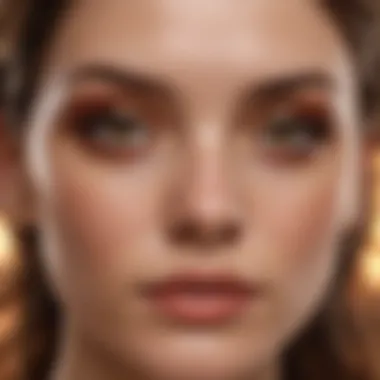
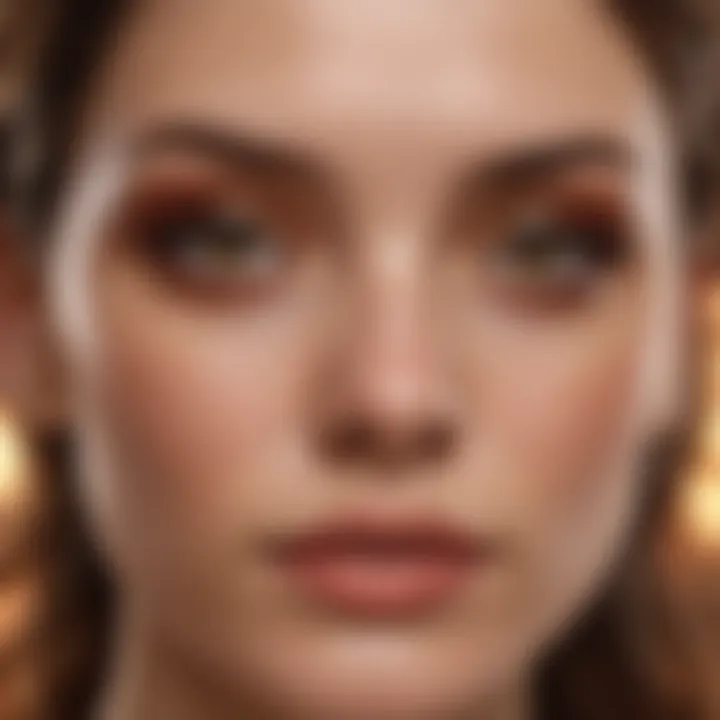
Application Techniques for Eye Tints
Applying eye tints effectively can significantly alter the outcome. There are conventional methods and innovative techniques that can enhance the application process:
- Brushes and Sponges: Using the right tools can make a notable difference. Brushes may provide precision, while sponges can create a soft, blended look.
- Fingers: Some users prefer using their fingers to apply tints, bringing warmth and allowing for better control.
- Layering: Starting with a base layer and gradually building up the color can create depth without overwhelming the eye.
It is recommended to start with minimal product and build up as needed. This technique prevents heavy applications that may not blend well. Additionally, blending is critical; seamless transitions between colors create a balanced aesthetic.
Ultimately, the art of applying eye tint lies in experimentation. With practice, individuals can discover what techniques work best for their personal style.
Brown Eyes in Popular Culture
The representation of brown eyes in popular culture extends beyond mere aesthetics; it reflects a mixture of cultural, social, and historical significance. Brown eyes are often seen as warm and inviting, evoking feelings of trust and stability. In various art forms, including film, literature, and music, brown-tinted eyes are frequently associated with depth of character and emotional resonance. This aspect makes them not just a physical trait but also a symbolic one, carrying connotations that influence perception and interpretation.
Cinematic Representation of Brown Eyes
In cinema, brown eyes have been portrayed in diverse ways, often shaping the audience's understanding of a character's personality and motivations. Films tend to use eye color to signify traits, with brown eyes frequently linked to reliability and down-to-earth qualities. For instance, characters with brown eyes often embody compassion or a sense of groundedness, differentiating them from the more commonly portrayed enigmatic blue or green-eyed characters.
Classic Hollywood often celebrated brown-eyed leading actors and actresses like Audrey Hepburn and Johnny Depp, enhancing the appeal of this eye color in the mainstream. Their portrayals not only contributed to the allure but also set a precedent for future roles with similar eye traits. Brown eyes have been cast in roles that require emotional depth and authenticity, showing a preference for actors who connect with the audience on a more genuine level.
Influence of Celebrities with Brown Eyes
Celebrities with brown eyes have undeniably impacted fashion and beauty standards across the globe. Icons such as Beyoncé, Angelina Jolie, and Mila Kunis showcase how this eye color can be both striking and versatile. Their influence extends to how makeup trends evolve as well, with techniques catered specifically for brown-eyed individuals, encouraging many women to embrace their natural tint rather than altering it.
Moreover, the visibility of these celebrities in media continues to reinforce a positive narrative surrounding brown eyes. Fashion brands and beauty companies often use these figures in their campaigns, further normalizing and celebrating the diversity of eye colors. It allows a wider range of women to see someone relatable, encouraging them to express their unique style while appreciating their brown tint.
"The presence of brown eyes in the spotlight serves to validate and highlight the beauty inherent in variety, promoting an acceptance of individuality in our aesthetic choices."
The cultural representations of brown eyes in both cinema and celebrity life result in a reinforced appreciation for this eye color, encouraging women to embrace their features. The insights gained from these portrayals emphasize brown eyes' richness and complexity, weaving them into the broader conversation of personal identity and cultural expression.
Impact of Lighting on Eye Color Perception
The perception of eye color is significantly influenced by the ambient lighting. Different lighting conditions can alter how the brown tint in eyes is viewed, often creating variations in intensity and hue. Understanding these effects is crucial for individuals wanting to showcase their eye color effectively. It adds depth to the discussion on brown eyes, highlighting the interplay between light and biological traits. In various settings, the eye color can appear warmer or cooler, impacting how one’s brown eyes are perceived by others.
Daylight versus Artificial Light
Natural daylight is a reliable source for observing true eye color. Sunlight provides a full spectrum of light, allowing all the colors in the brown tint to emerge clearly. Under daylight, brown eyes often look vibrant and rich, exhibiting subtle highlights that can change depending on the angle of the sun.
In contrast, artificial lighting can distort eye color. For example, incandescent bulbs may emphasize warm tones, making brown eyes appear more golden, while fluorescent lights may create a cooler appearance, sometimes making brown look more greyish.
- Daylight: Best for true representation. Enhances warmth and depth of brown.
- Incandescent Light: Increases warmth, golden tones become amplified.
- Fluorescent Light: Can create cooler, less flattering variations.
Considering the type of light when applying makeup is also important. Makeup that looks great in daylight may not have the same effect under artificial lighting.
Photographic Techniques for Eye Enhancement
To capture the true essence of brown eyes in photographs, specific techniques can be utilized. Proper lighting and angle play vital roles in showcasing the rich variations of brown tint. Here are a few approaches:
- Use of Natural Light: Shooting during the golden hour, just after sunrise or before sunset, provides soft light that enhances the warm tones in brown eyes.
- Selecting Backgrounds Carefully: A contrasting background can help draw attention to the eyes. Neutral colors often work best, allowing the brown to pop.
- Close-Up Shots: For capturing details in eye color, tight framing can reveal the unique flecks and shades within the brown.
- Adjusting Camera Settings: Using a wider aperture can help create a soft background, emphasizing the eyes.
"Lighting can make or break an image; it determines the perception of colors in a photograph."
By deploying these techniques, photographers can not only enhance the brown tint but also create images that capture the viewer’s attention with stunning accuracy.
Sustainable Practices in Eye Makeup
In recent years, there has been a notable shift towards sustainable practices in the beauty industry, reflecting a growing awareness of environmental issues. This focus on sustainability is particularly relevant in eye makeup, as products often contain chemicals and unsustainable ingredients that can harm both health and the planet. By prioritizing sustainability, makeup users can contribute to a more eco-conscious beauty regime, all while enhancing their natural beauty and expressing their style.
The importance of sustainable practices in eye makeup lies in the benefits derived from eco-friendly options. Not only do these products reduce the carbon footprint, but they also minimize the use of harmful chemicals. This is crucial for products applied so close to sensitive areas like the eyes. Additionally, sustainable practices encourage a shift away from fast fashion and promote thoughtful purchasing, leading to better choices that reflect personal values.
Considerations about sustainable practices include understanding the lifecycle of beauty products. Ingredients that are sourced ethically and packaged responsibly contribute greatly to this effort. Consumers can check labels and opt for certifications that indicate a commitment to sustainability.
Eco-Friendly Makeup Brands
Several brands have taken steps to offer eco-friendly eye makeup options. Choosing these brands can make a significant difference in one’s beauty routine. Some noteworthy brands include:
- 100% Pure: Known for its organic makeup, it uses fruit pigments and natural ingredients, making it a favorite for eco-conscious consumers.
- Ilia Beauty: This brand focuses on sustainability and transparency, using natural ingredients and responsible sourcing.
- RMS Beauty: It emphasizes using raw, food-grade ingredients, ensuring that all products are safe for skin and the environment.
These brands are emblematic of a movement that prioritizes health and environmental considerations, setting a standard for quality and ethics in the beauty industry.
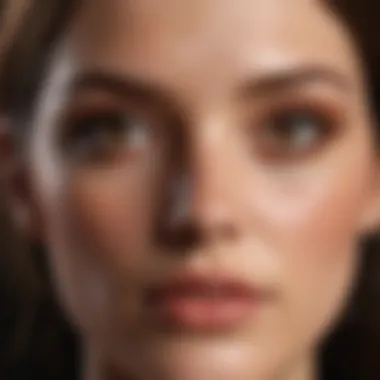
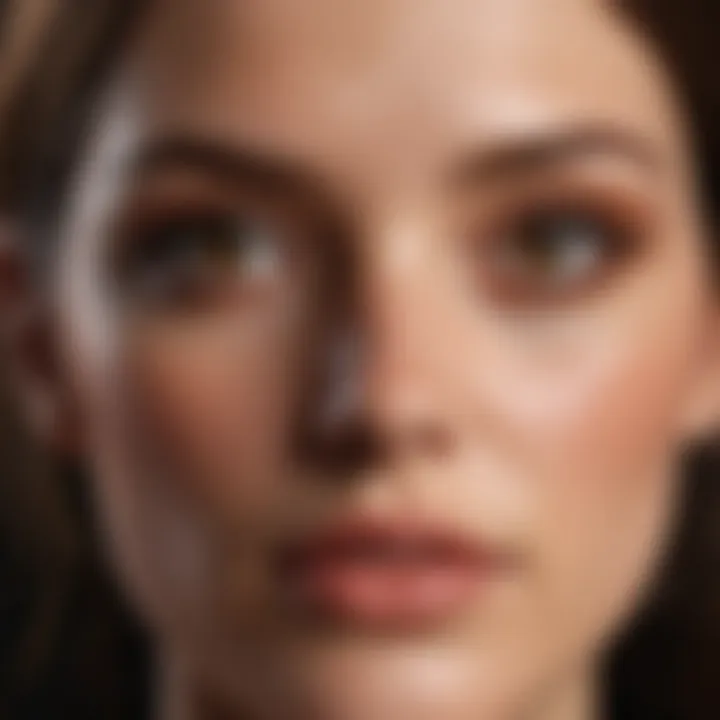
Natural Ingredients for Eye Products
When selecting eye products, natural ingredients become a crucial benchmark. They not only reduce the risk of irritation but also promote healthier skin and eyes. Common natural ingredients favored for their effectiveness and safety include:
- Shea Butter: Hydrates and soothes delicate skin around the eyes.
- Coconut Oil: Acts as a moisturizing agent and can help in removing makeup gently.
- Beeswax: Provides a protective barrier without clogging pores, ideal for eye makeup.
Opting for products that utilize these natural ingredients can lead to improved eye health and overall skin condition, aligning with a sustainable beauty philosophy.
"Sustainable practices in eye makeup not only enhance beauty but also demonstrate responsibility towards personal health and the environment."
Embracing sustainable practices in eye makeup creates a holistic approach to beauty that benefits both individuals and the planet, embodying the essence of conscientious beauty choices.
Personal Expression through Eye Color
Personal expression through eye color is central to understanding how individuals convey their identity. Brown eyes, with their often warm and inviting hue, serve as more than just a biological feature; they are a canvas for self-expression. Makeup and fashion choices become strategies to enhance the natural beauty of brown-tinted eyes, allowing individuals to communicate their personality or mood.
Choosing Makeup Based on Eye Tint
Selecting the right makeup based on eye tint is a crucial factor for achieving a balanced and harmonious look. The key is to complement rather than overpower the natural shade. For brown eyes, earthy tones such as gold, bronze, and deep greens create a striking contrast that enhances their warmth.
- Eyeshadows: Earthy palettes work best. Shades like taupe or warm browns emphasize the depth of brown eyes, while shimmering golds bring out their radiance.
- Eyeliners: Rich browns and dark taupes can make brown eyes pop without an over-the-top effect. Alternatively, deep blues and greens create a dramatic contrast.
- Mascaras: Black mascara is a classic choice, yet brown mascara can harmonize with the softer hues of brown eyes, resulting in a natural look.
Additionally, considering factors such as skin tone and personal style is essential. Medium skins might choose warm tones, while cooler skin tones may prefer shades with a bit of blue.
Fashion Choices Complementing Brown Eyes
Fashion choices significantly impact how eye color is perceived. When dressing with brown eyes in mind, colors that enhance the warm undertones should be prioritized.
- Clothing Colors: Earthy and neutral palettes such as beige, cream, or olive greens flatter brown-tinted eyes perfectly. Rich jewel tones like emerald or deep burgundy can create a striking ensemble while bringing the eyes into focus.
- Accessories: Jewelry in warm metals like gold or copper emphasizes the warmth of brown eyes. Moreover, scarves or hats that incorporate patterns featuring these colors can act as frame that draws attention to the face.
"The choices we make in fashion and makeup do more than just enhance our appearance; they express parts of our identity."
Ultimately, the fashion and makeup choices should align with an individual’s personality and comfort level. Each selection forms a visual dialogue that reflects personal style while celebrating the unique beauty of brown eyes.
Health Considerations of Eye Tinting
When exploring the aesthetics of eye color, it is crucial to examine the health considerations associated with the use of eye tint products. These considerations not only pertain to the potential physical risks but also to practices that ensure safe usage. Understanding these elements is vital for anyone who desires to enhance their eye appearance while maintaining eye health and safety.
Potential Risks of Eye Tint Products
Eye tint products, like any beauty product, may carry certain risks. The following are some of the notable concerns:
- Allergic Responses: Ingredients in eye tints can cause allergic reactions in sensitive individuals. Symptoms may include redness, swelling, or itching.
- Irritation: Continued use of certain chemicals in eye tints might create irritation on the eyelids or the tissue surrounding the eyes.
- Infections: Improper application or shared products can lead to the transfer of bacteria, increasing the risk of eye infections, such as conjunctivitis.
- Chemical Exposure: Excessive exposure to chemicals found in eye tints may have long-term effects on eye health, although research on this topic is ongoing.
It is essential for users to conduct patch tests and to read ingredient labels carefully to avoid harmful effects. Consulting a healthcare professional before using any new cosmetic product is highly recommended. This can prevent unwanted outcomes associated with eye care products.
Safe Application Practices
To mitigate the risks associated with eye tint products, implementing safe application practices is fundamental. Here are some key guidelines:
- Patch Testing: Always perform a patch test on skin before applying the product near the eye. This helps identify any potential allergic reactions.
- Hygiene Standards: Ensure all tools, such as brushes and applicators, are clean and free from bacteria. Wash your hands before applying any products.
- Read Instructions: Follow the manufacturer's instructions carefully. Each product may have specific guidelines regarding application and removal.
- Avoid Sharing: Do not share your eye tint products with others to minimize the risk of spreading infections.
- Limit Frequency: Regular use of eye tints can have cumulative effects. It is wise to limit usage according to individual skin tolerance and needs.
Good practices in handling beauty products enhance not only appearance but also health.
By adhering to these practices, individuals can significantly reduce the potential health risks associated with eye tints while enjoying the benefits of enhanced eye aesthetics.
Ending: Embracing Brown Eyes
The conclusion of this article emphasizes the significance of brown eyes, revealing not just their aesthetic value, but also how they contribute to personal identity and cultural contexts. Brown eyes are the most common eye color worldwide, yet they possess unique traits that set them apart. By understanding the nuances of this specific eye tint, individuals can better appreciate it as a distinct attribute that reflects their personal and cultural identity.
The Value of Brown Tint in Personal Identity
Brown tint in eyes can be a profound expression of individuality. Many find that their brown eyes resonate with their cultural background. In certain cultures, brown eyes are seen as symbols of warmth, nurturing, and loyalty. These associations can enhance one’s self-image and confidence.
In addition to cultural aspects, the shade and depth of brown tint can vary widely, influencing how people relate to their appearance. Some may find that certain shades of brown make them feel more connected to their roots or heritage. The diversity in brown eye tones also allows for personal expression, as individuals can select fashion and makeup choices that either complement or contrast their natural eye color.
Caring for brown eyes, with regard to health and aesthetics, also becomes a means of self-affirmation. This dedication not only supports eye health but also can enhance their natural beauty, providing a sense of empowerment.
Future Trends in Eye Aesthetics
Looking ahead, the aesthetics associated with brown eyes are evolving within the broader scope of beauty trends. As the demand for inclusivity and diversity persists in the fashion and beauty industries, there is a growing appreciation for varying shades of brown. This movement moves away from one-dimensional ideals of beauty.
Eye makeup products designed specifically for enhancing brown tint are becoming increasingly sophisticated. These products focus on personalization, ensuring that shades complement the unique undertone of each individual's brown eyes. Moreover, there is a trend toward using sustainable and natural ingredients in makeup, reflecting a broader societal desire for environmentally conscious choices.
The influence of social media cannot be overlooked. Platforms like Reddit and Facebook host discussions that allow users to share tips for enhancing brown eye color, from recommendations for specific makeup brands to tutorials about application techniques. This community engagement fosters a culture of learning and expression that benefits all individuals with brown eyes. Moreover, as beauty standards become more elastic, the acceptance of brown eyes as a striking feature is likely to permeate mainstream culture in new ways.







